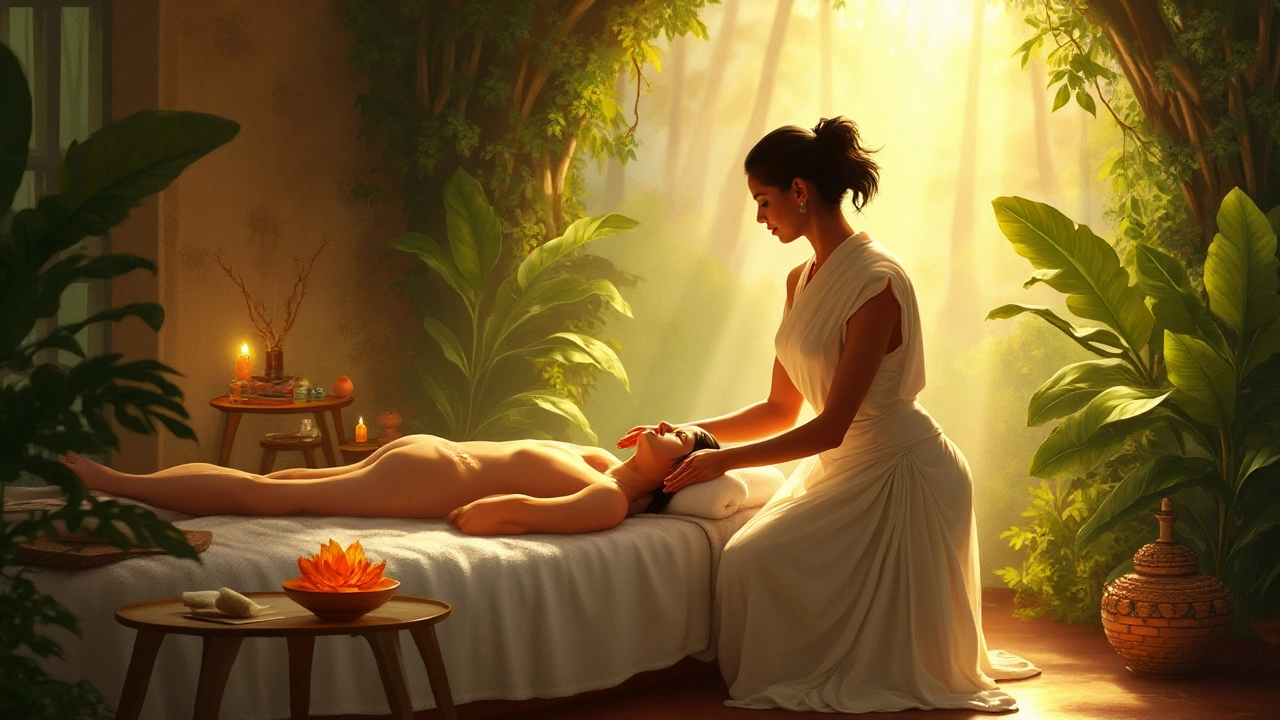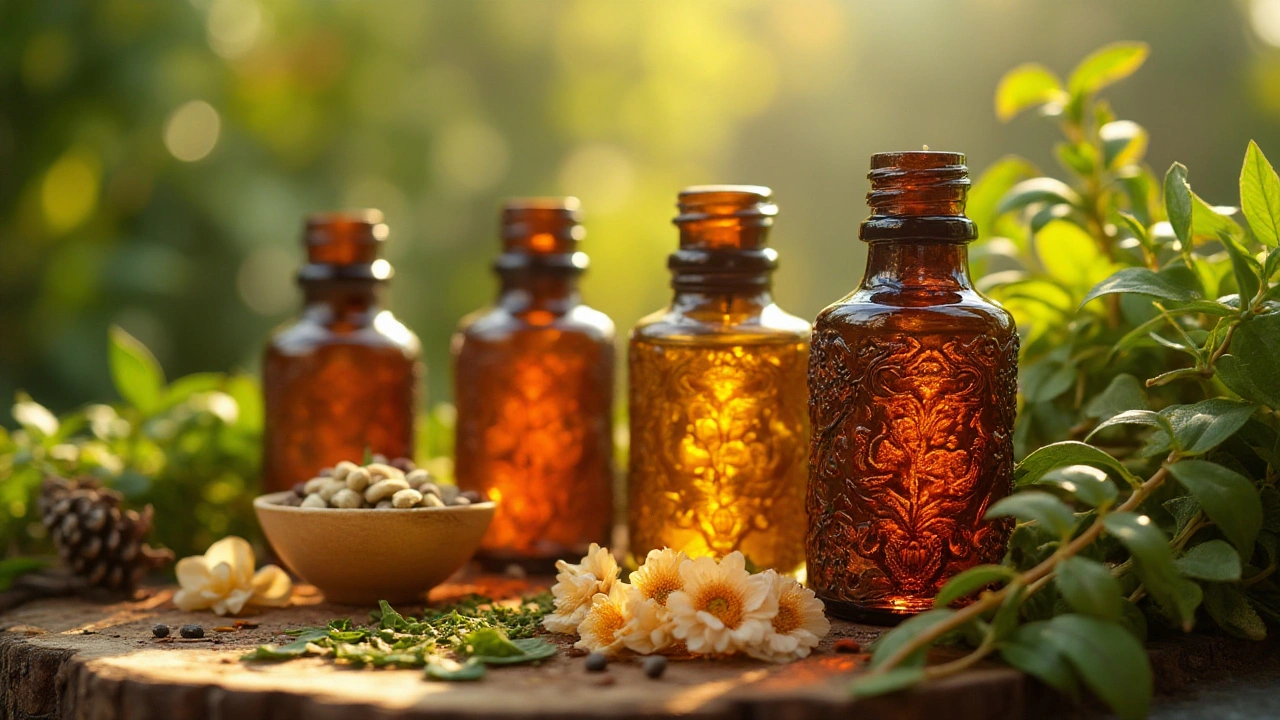Unlock the Secrets of Ayurvedic Massage for Your Well-being
 Feb, 2 2025
Feb, 2 2025
In the hustle and bustle of our modern lives, it's easy to overlook the ancient wisdom passed down through generations. One such treasure is Ayurvedic massage, a deeply rooted practice in holistic health that offers pathways to rejuvenation and mental clarity. Stemming from the ancient Indian science of Ayurveda, this massage form harmonizes the body with the rhythms of nature.
With techniques that have been honed over millennia, Ayurvedic massage doesn't merely relax you; it connects you to a profound heritage of healing. Embracing this practice invites an exploration into rich traditions of herbal oils and intentional touch designed to replenish the spirit and detoxify the body. As we delve into the intricacies of this massage, discover how it can become a soothing balm for the stresses of contemporary life.
- Origins of Ayurvedic Massage
- Techniques and Practices
- Health Benefits
- Choosing the Right Oils
- Incorporating Ayurvedic Massage Into Your Routine
Origins of Ayurvedic Massage
The origins of Ayurvedic massage can be traced back over 5,000 years to ancient India, where the holistic approach was developed as part of the broader Ayurvedic system of medicine. Ayurveda, which translates to 'the science of life,' is based on the principles of balancing the three doshas—Vata, Pitta, and Kapha—within the body to promote optimal health. In ancient times, Ayurvedic practices were not merely health treatments; they were a way of life intended to prevent illness, enhance well-being, and support spiritual growth.
When it comes to historical significance, Ayurvedic massage was prominently practiced during the reign of King Ashoka in the 3rd century BCE, a king known for his patronage of Ayurveda and its practices. The Charaka Samhita and Sushruta Samhita, foundational texts in Ayurveda dating back to this era, detail the use of massage to purify and balance the body's systems. This method was not only a tool for healing but a revered ritual that was imbued with spiritual significance.
"Ayureda... was not devised as a tradition of mere cure, but to ensure that harmony between our body, mind, and spirit was maintained." — Vasant Lad, The Complete Book of Ayurvedic Home Remedies
Ayurvedic massage incorporates a variety of techniques, each with its own purpose, from subtle energetic balancing to deep tissue manipulation. The traditional practitioners, known as vaidyas, were highly respected, often serving as advisors to the royal courts regarding health and wellness. Their practices were strictly adhered to the guiding principles laid out in the ancient texts, emphasizing the importance of personalized treatment plans based on one's unique constitution.
With a focus on herbs and oils, the healing power of Ayurvedic massage was amplified through the use of natural materials sourced from the abundant Indian landscape. Oils like sesame and coconut are often infused with specific herbs for their therapeutic effects, tailored to correct imbalances in the doshas. These oils were integral to therapy, enhancing touch's effectiveness in releasing stored toxins and harmonizing energy flow throughout the body.
As the practice of Ayurvedic massage evolved, it began to incorporate influences from various cultures. The Silk Road facilitated the exchange of knowledge and traditions, enriching Ayurvedic practices with new techniques and understandings. Despite these adaptations, the core philosophy has remained intact, providing people worldwide with an effective and natural approach to health. Today, Ayurvedic massage continues its enduring legacy, attracting those in search of holistic healing and a deeper connection with their inner self.
Techniques and Practices
Ayurvedic massage, distinct for its comprehensive approach, integrates a variety of techniques aimed at promoting physical and mental wellbeing. An essential aspect is its use of specially prepared herbal oils, which are believed to penetrate deeply to detoxify the body and soothe both tissues and mind. These oils are chosen based on the individual's unique body constitution or dosha—Vata, Pitta, or Kapha—ensuring a personalized experience that aligns with one's innate balance.
One of the core techniques is Abhyanga, which involves a rhythmic and firm stroking methodology that enhances circulation and stimulates the lymphatic system. Each stroke is synchronized with the client's breathing patterns, creating a harmonious flow that resonates with the natural energy channels, or nadis, within the body. Abhyanga's efficacy is partly due to the warm oil used during the process, which not only nourishes the skin but also fosters a calming environment that mitigates stress.
Marma Therapy
Another integral practice within Ayurvedic massage is Marma Therapy, which focuses on 107 pivotal points located at junctures of the body's muscular, vascular, glandular, and nervous systems. By applying gentle pressure to these points, therapists can influence the life force, or prana. This technique facilitates the unblocking of energy, promoting holistic healing and overall vitality. Marma points are seen as junctions of consciousness and physiology—attesting to the in-depth wisdom Ayurveda holds.
Dr. Vasant Lad, a respected Ayurvedic physician, once remarked, "The subtle science of Marma therapy can be a wonderful adjunct to achieve higher states of healing and to gain access to the quantum healing field that exists beyond time and space."
For those seeking an invigorating experience, Ayurvedic massage often includes Pizhichil, a luxurious therapy where warm, medicated oil is poured continuously over the body while massaging simultaneously. It's an enveloping procedure that not only relieves pain and muscle tension but also fosters a profound sense of tranquility. Practitioners view Pizhichil as a therapeutic reservoir for releasing emotional blockages.
- Ayurvedic massage often begins with the head, where techniques like Shiro Abhyanga are performed, emphasizing the nourishment of hair and scalp through invigorating strokes.
- Post-massage, a cleansing ritual known as Swedana is sometimes offered to enhance the elimination of toxins through induced perspiration, further aiding in the cleansing process.
Incorporating these varied techniques and practices within Ayurvedic massage not only addresses physical ailments but also nurtures emotional and spiritual wellbeing, allowing individuals to experience a holistic transformation. These methods, refined through centuries, highlight a sophisticated understanding of interconnectedness within the human body that modern stress just can't eclipse.

Health Benefits
Discovering the health benefits of Ayurvedic massage is like peeling back layers of an ancient text, revealing insights into how touch and natural elements interact to promote well-being. At its core, Ayurvedic massage is not just about kneading muscles; it involves a comprehensive understanding of the body’s doshas—Vata, Pitta, and Kapha—and how they dictate physical and emotional health. These doshas must remain in balance, and an Ayurvedic practitioner tailors each session based on the individual’s unique needs. By realigning these energies, one can expect improved overall health, including enhanced circulation, reduced inflammation, and strengthened immunity. Through careful strokes and the use of herbal oils, the body not only relaxes but also starts to self-heal, reflecting the massage's ancient wisdom in motion.
"Ayurvedic practices, including massage, are integral in rejuvenating bodily tissues and fostering longevity," says Dr. Deepak Chopra, a renowned advocate for integrative medicine.
The benefits of Ayurvedic massage extend beyond physical rejuvenation. Imagine the stress of urban life melting away as subtle yet effective techniques guide the body into a blissful state of deep relaxation. This form of massage has been shown to significantly reduce stress hormones in the body, which can enhance mental clarity and emotional stability. For individuals struggling with anxiety or chronic stress, Ayurvedic massage can serve as a pivotal tool. The rhythmic movements and warm oils soothe the nervous system, promoting a feeling of well-being and tranquility. This is not merely anecdotal; studies have quantified the decrease in cortisol levels following regular massage sessions.
For those keen on detoxifying the body, Ayurvedic massage offers profound benefits. By stimulating the lymphatic system, it encourages the removal of toxins and excess fluids, leading to clearer skin and increased energy levels. Imagine each stroke aiding in flushing out impurities, akin to cleansing a vessel filled with life-giving water. This detoxification process not only strengthens the immune system but also enhances the body's natural healing capabilities. Many who embrace this practice report a rejuvenated sense of vitality and wellness.
Moreover, Ayurvedic massage is known for its ability to improve flexibility and joint mobility. This is particularly beneficial for individuals experiencing symptoms of arthritis or muscle stiffness. Through targeted pressure and the natural elasticity promoted by heated oils, muscles and joints are gently coaxed into greater range and strength. It is no wonder that people return from their sessions feeling a newfound lightness in their step, as their bodies shed the weight of discomfort and restriction.
For anyone curious about how Ayurvedic massage might specifically benefit them, it’s vital to consider the role of the oils used. Derived from natural sources, such as sesame or coconut, these oils are infused with herbs tailored to suit individual doshas. They act not only as mediums for massage but also impart their own therapeutic properties. These carefully crafted mixtures can reduce inflammation, promote skin health, and introduce antioxidants to the body. The aromatic qualities of the oils add to the sensory experience, enhancing relaxation and mental balance.
In conclusion, this comprehensive approach harnesses the healing power of the mind-body connection through strategic touch and natural therapies. The impacts are varied and profound, ranging from stress reduction and improved circulation to enhanced flexibility and detoxification. Whether seeking relief from physical ailments or merely desiring a mental reprieve, Ayurvedic massage offers a pathway to holistic health and well-being.
Choosing the Right Oils
One of the most distinctive aspects of Ayurvedic massage is its use of warm herbal oils specially selected to address an individual's unique constitution, or 'dosha'. Picking the right oil is not merely about preference but understanding your body's unique needs. The three primary doshas—Vata, Pitta, and Kapha—each have their characteristics and require different types of nourishment. For instance, Vata types, often associated with dryness and coolness, benefit from oils that are warming and grounding, like sesame oil. On the other hand, Pitta types might seek the cooling properties of coconut oil to balance their fiery nature. For Kapha, which tends to be more stable but sluggish, a lighter oil such as mustard is often recommended.
The blend of herbs infused in these oils can enhance their healing properties significantly. For example, Ashwagandha is revered for its properties that strengthen and invigorate the body. Similarly, Brahmi is frequently used for its ability to promote calmness and clarity of mind. Such herbal infusions can target specific ailments or enhance the overall therapeutic effect. Choosing the right oils involves not just knowing the properties of the oil but also listening to your body’s signals and, sometimes, even the season.
Experts often recommend considering the climate when selecting an oil. During colder months, warming oils can keep the body balanced and resilient. In contrast, in the summer, lighter and cooler oils help maintain an equilibrium. As Dr. Lunawat, a known Ayurvedic practitioner, once said, "The ideal oils are those that harmonize with both nature’s rhythms and our own."
In Ayurveda, understanding our close relationship with nature and how it affects us signifies a deep respect for tradition and self-awareness.
For those new to Ayurvedic massage, it might be beneficial to consult with an Ayurvedic practitioner. They can offer personalized advice that often includes dietary suggestions alongside recommendations for oils. Using the correct type of oil is a cornerstone of effective Ayurvedic massage, bridging the ancient rituals of healing with the scientific understanding of today. Choosing the right oil involves embracing a holistic approach where the mind, body, and environment are all considered parts of a larger, interconnected whole.

Incorporating Ayurvedic Massage Into Your Routine
Adding Ayurvedic massage to your routine might seem daunting at first, but with a little dedication, it can become a cornerstone of your wellness journey. This form of massage is not just a treatment; it's an art that gently guides you towards a balanced state of being. To begin, select a quiet space in your home where you can unwind without disturbances. Creating a serene environment with soft lighting and calming music can significantly enhance your experience, turning an ordinary room into a personal sanctuary. In this environment, connecting the mind and body becomes an effortless endeavor.
Before commencing the massage, choose the right herbal oils that resonate with your specific dosha—be it Vata, Pitta, or Kapha. Ayurvedic principles emphasize the use of natural oils like sesame for dry skin, coconut for cooling effects, or mustard for improved circulation. Understanding your dosha is pivotal in selecting the correct oils and techniques that suit you best. Massage practitioners believe that the oil, when warmed slightly, facilitates deeper penetration into the skin, allowing the properties of the herbs to work more efficiently. You'd be amazed at how a small amount of warm oil can usher in a wave of tranquility, aiding relaxation and amplifying the healing power of this age-old technique.
As you settle into the practice, focus on rhythmic strokes that follow the contours of your body. Ordinarily, clockwise circular motions on the joints and longer strokes on the limbs work best. The key is consistency; aim for a massage session once a week to start. As you become more adept, gradually increase the frequency to twice a week. Incorporating these sessions into your routine is not just about maintaining physical health; it's also a meditative practice that grounds you, offering clarity amid the chaos of modern life.
For those wishing to delve deeper, consider consulting with an Ayurvedic practitioner. A trained therapist can offer personalized guidance, introducing you to more advanced techniques and practices that align with your wellness goals. Many people find that a blend of self-massage at home combined with periodic sessions from a professional creates the most rewarding experience. As the celebrated Ayurveda expert, Dr. John Douillard, once said, "Ayurvedic massage invites a sacred dialogue with your inner self, a conversation of healing and connection."
Beyond the tactile aspects, consider the inclusion of lifestyle changes that align with Ayurvedic principles. Simple adjustments such as prioritizing a balanced diet, regular exercise, and a regimented sleep schedule can amplify the benefits of your massage routines. Ayurveda is holistic, advocating for a symbiosis between your physical, mental, and emotional wellbeing. This trinity of balance will ensure you harness the full potential of the practice, achieving a life filled with vitality and peace.
To encapsulate your progress and experiences, maintain a journal. Recording each session can be insightful, allowing you to reflect on the sensations you experience and the stresses you've released. In time, this record becomes a narrative of healing and self-discovery, an unfolding story of how Ayurvedic massage transforms not just your body, but your life's rhythms. As more people embrace this ancient wisdom, they find themselves not just hearing but truly listening, not just seeing but fully observing the nuances of their daily lives.
